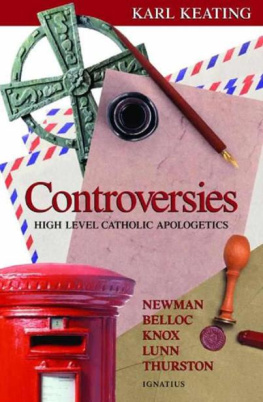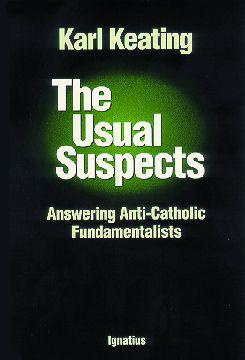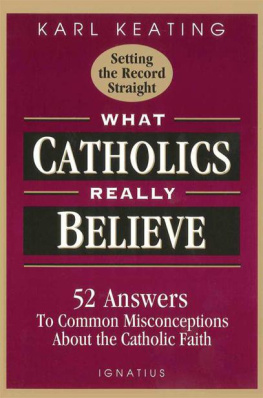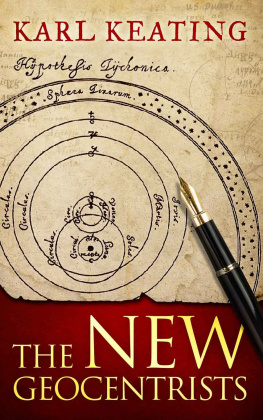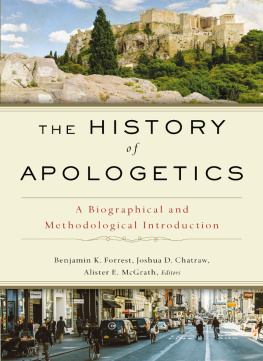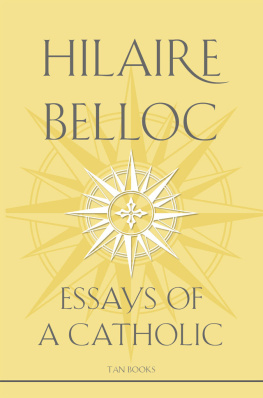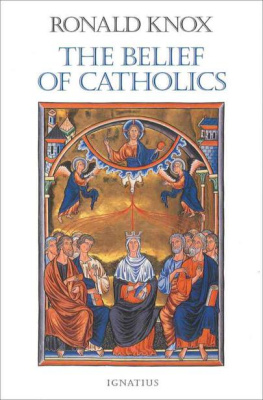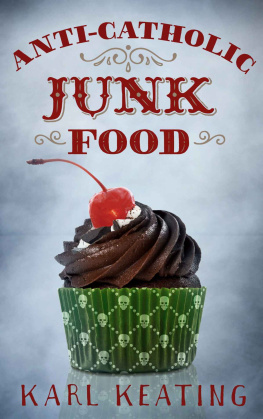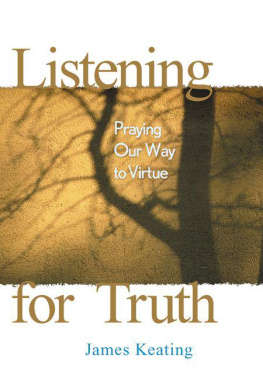CONTROVERSIES
KARL KEATING
CONTROVERSIES
High-Level Catholic Apologetics
IGNATIUS PRESS SAN FRANCISCO
Cover design by Roxanne Mei Lum.
2001 Ignatius Press, San Francisco
All rights reserved
ISBN 0-89870-828-1
Library of Congress control number 2001088856
Printed in the United States of America
In grateful memory of
Isaac Don Levine
CONTENTS
PREFACE
Toward the end of my undergraduate years, a prominent defector from the Soviet Union spoke on campus. I arrived at the hall early and found a seat near the front, two places away from an elderly man and his wife. I brought along a fat book to occupy myself until the start of the lecture. After a few minutes, the man spoke across the empty seat between us. May I ask the title of that book? I said it was Whittaker Chambers Witness . What do you think of it? I answered by saying I was on my second reading. He smiled knowingly. Permit me to introduce myself to you. He reached for the book and opened it to the index. From his suit pocket he fished out a stubby pencil and made a check mark next to the entry Levine, Isaac Don. That is how I met one of the participants in the Hiss-Chambers case and a man who had been a prominent foreign correspondent for more than half a century.
Over the next three years I periodically visited Don and Ruth Levine at their winter home some miles north of the university. Although long past retirement age, he had not retired from writing. He remained an active journalist until the end. Born in 1891 northwest of Kiev, in the town of Mozyr (which, he noted, was mainly Jewish but included two thousand Catholics), he did not seem to be a religious man, but he had a heart for truth. He had seen much of the world and had tried to learn from what he had seen.
An immigrant to the United States, Levine returned to Russia during the Revolution to report on events for American newspapers. He accompanied Trotsky to the front and went to Ekaterinburg to investigate the murder of the imperial family. He reported the confused events following Lenins death and the struggle between Trotsky and Stalin. He became close friends with Alexander Kerensky, whose shortlived government had been overthrown by Lenin. With Lincoln Steffens and Ernest Hemingway he observed Benito Mussolinis debut as a statesman at the Lausanne Peace Conference. In later years he came to know Albert Einstein and Joseph McCarthy, and he traveled throughout the Middle East and saw firsthand the political volatility of Iran when it was under the Shah. Levine was a repository of facts, dates, and quotations.
One of the last times I saw him was at the university library. He was attended by his wife, who steadied him as he walked. He said he was finishing up a book and had been downstairs in the microfilm room, where he had looked up a single headline that had appeared in The New York Times around World War I. He wanted to make sure he had remembered the wording correctly. I was taken by his devotion to precision. At his age, in his condition, he could have made worthy excuses for not engaging in any but the most necessary research. He could have sent off the manuscript with a headline that possibly was misrememberedwho would have checked up on him? It did not matter that no one would have bothered to do so. He went to the microfilm room not so much for his future readers as for himself. He was devoted to accurate reporting because he was devoted to truth.
Levines search for truthin his case, historical truthdid not endear him to everyone. More than once, he wrote in his autobiographical Eyewitness to History , I found myself described as a controversial personality. The appellation was not always meant as a compliment. Not everyone appreciated his digging beneath accepted opinions and, worse, challenging them. Some people shy away from controversy and from those engaged in it, but I found Levine all the more attractive for having lived a life of intellectual tension. He wanted to know, and his search for knowledge sometimes rankled others. No matter. To thine own self be true, counseled Polonius.
If it can be said that a mans personality is reflected in the reading he enjoys, then my own personality tends toward the controversial, for I enjoy works that defend a position strongly held. This is especially true regarding religion, the most important subject of all. Religious controversy is considered by many to be a relic of a triumphalistic past. Worse, it is socially obtuse. As recently as a lifetime ago a controversial exchange was understood to be one in which two parties expressed decided but gentlemanly disagreement. The truth mattered to them, and they thought it worth fighting over, even though their only weapons were words. They thought that good things arose from a grasp of truth and evil things from a rejection of truth. Today reasoned controversy is unfashionable, and a desire for truth has given way to indifferentism. It no longer matters if such-and-so is true: There is a truth for you and a truth for me. There is nothing to argue about if everyone is right, if all beliefs are true, if all opinions are valid. If modern culture has a patron saint, it is Pontius Pilate, who ironically inquired, What is truth?ironically, because the poor man did not realize that he had Truth staring him in the face.
In the following pages are offered eight examples of high-level controversial writing, culled from some of my favorite books. Each selection is a forceful exposition of Catholic truth. Most of them are from the 1930s, all of them come from British Catholics, and all of them are aimed at a single antagonist, with the public invited to look over the writers shoulder. Four are taken from book-length exchanges of correspondence, a format that lets the reader view the weaknesses and occasional mistakes even of his own champion. In all of the pieces the reader finds vivid personalities. These were men who knew the Catholic faith and could explain it to others. The individuals to whom or against whom they wrote may not have been convertedone or two were, in the long runbut any number of readers of these now-forgotten masterpieces must have found their faith bolstered and their doubts assuaged.
The first selection is from John Henry Newmans Apologia pro Vita Sua . It is a rhetorical flourish that was excised from the second and later editions of that justly famous work. There follow two short essays by Hilaire Belloc, he of the cool logic, one replying to J. B. S. Haldane, the other to Dean Inge. Then Ronald Knox writes to Arnold Lunn, who, at the time of writing, was not yet a Catholic. Next are three pieces by the Catholic Lunn and one by Herbert Thurston, a Jesuit historian well known in his time but almost completely forgotten in ours. The eight selections are arranged chronologicallythe first appeared in 1865, the last in 1946, and the rest from 1931 to 1937and, in a preface to each, I introduce the characters and set the stage.
In one-on-one exchanges such as these there is, unavoidably and desirably, a personal element. Newman says of Charles Kingsley that though I am writing with all my heart against what he has said of me, I am not conscious of personal unkindness towards himself. The intensity of Newmans writing does not detract from its politeness. Belloc explains that a personal tone suffuses his remarks: I can write no other way, and his writing is the stronger for it. Historian G. G. Coulton tests Thurstons and Lunns patience, but neither Catholic strays from apologetical rectitude. Lunn tells the agnostic C. E. M. Joad that though we differ on fundamental issues, we are not personally antipatheticafter all, he notes, There is always hope for a man, however perverse his views, who prefers Van Eyck to the post-impressionists. Good-natured repartee joins with sharp argumentation. The stakes are high in these essays, but so is the courtesy.
Next page
